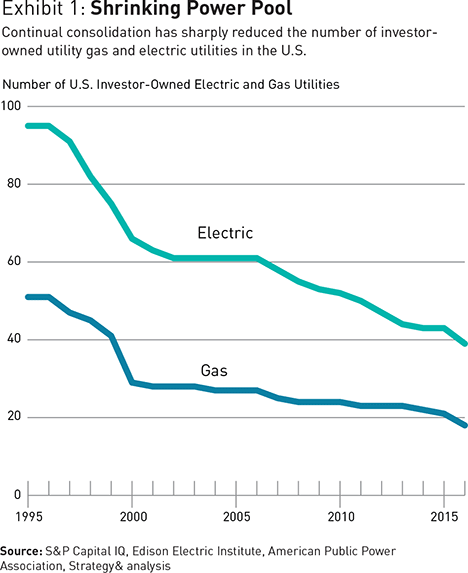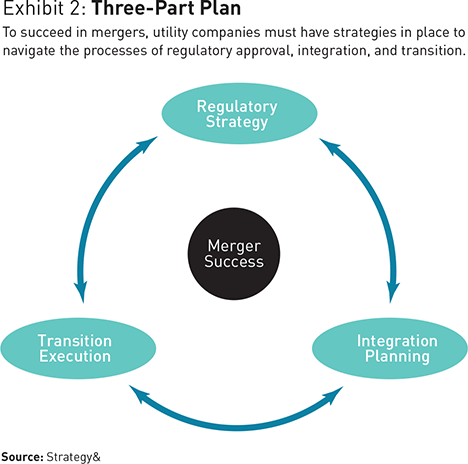A New M&A Strategy for Utilities
Utilities seeking to expand must be able to negotiate regulatory complexity while planning and executing deals effectively.
In April, Texas regulators rejected a bid by Florida utility giant NextEra Energy to acquire Dallas-based Oncor Electric, whose parent company was in bankruptcy. The regulators expressed concern that Oncor’s new board would be controlled by an out-of-state entity, which would impair local decision making. In May, Kansas regulators turned down the proposed sale of electric utility Westar Energy to Missouri-based electric utility Great Plains Energy, saying they were concerned about the financial leverage of the combined entity and its potential disadvantages for customers.
The deals are still pending. But these events show that mergers and acquisitions, which have been common in the utilities industry, could face heavier scrutiny going forward. That means utilities seeking to gain a competitive edge through M&A will have to convince regulators that the transactions will produce meaningful efficiencies and synergies. They must also show how their plans will translate into explicit benefits for ratepayers and improvements to transmission and distribution networks.
During the past two decades, the utilities sector has consolidated broadly. Since 1996, the number of U.S. investor-owned electric and gas utilities has decreased by around 60 percent, and the median market cap in the industry has risen to US$7 billion from $1 billion (see Exhibit 1).
Consolidation has been driven by several factors. Some utilities have been seeking to diversify regulatory risk by having operations in multiple states. Others have sought complementary assets, such as gas pipelines, or expanded into new service functions, such as gas distribution or electric generation. Regardless of the motivating factor, the overall outcome is clear. The utilities industry is top heavy; it has a majority of large companies and a shrinking minority of smaller companies.
As the opportunities for M&A narrow, the need for M&A as a vehicle for growth persists. Utilities face some significant challenges unique to their industry. Revenue gains from traditional areas such as power generation and distribution have stalled for most utilities. As services have accounted for a greater share of economic activity, demand for electricity in the economy has flattened. In some areas, demand is even declining, because population and business expansion is more than offset by energy efficiency and conservation efforts. In its annual financial review, the Edison Electric Institute reported that the number of gigawatt-hours available for distribution in 2016 was 2 percent lower than the 2008 figure.
With few organic growth options available, larger utilities — whether they are based in the U.S. or Canada — seeking growth have no choice but to try swallowing up smaller companies outside their home regions. Many traditional electricity providers are particularly interested in natural gas utilities. Thanks to the fracking revolution, natural gas has emerged as a plentiful, relatively low-priced feedstock that produces fewer emissions than coal or oil.
But as noted above, utilities seeking mergers don’t have a free hand, as companies in other industries might. State regulatory commissions as well as company shareholders weigh in on the merit of any transactions, which means that different stakeholder needs must be considered. In today’s utility sector, a fruitful M&A strategy — one that can provide a lucrative return on investment — contains three essential elements: the ability to navigate the regulatory approval process; a well-crafted initial integration plan that identifies specific gains and synergies; and a transition program designed to capture the projected value as soon as the acquisition is approved and finalized (see Exhibit 2).
Regulatory Strategy
Utilities-sector M&A cannot be approached as a one-size-fits-all effort. Utilities are regulated at the state level. And each state commission has different biases as to what it wants to see in an acquisition and what gains the deal has to deliver to the state’s constituents. For that reason, utilities need to approach a deal with sufficient up-front knowledge about what regulators are seeking. And they must be able to craft the application in ways that satisfy the commission’s goals or that can provide provisions regulators would welcome while ensuring shareholder returns.
Utilities are increasingly focused on making promises in areas such as maintaining current employment levels (or sometimes even increasing them), protecting local management, providing rate benefits to customers, and making ongoing investments in infrastructure. To gauge how regulators will receive an application, acquiring utilities should assess whether it demonstrates tangible benefits for customers and improves local economic conditions — or at least offers trade-offs that are advantageous to the community.
For instance, in 2016, when North Carolina–based electric and gas utility Duke Energy purchased a smaller North Carolina–based utility, Piedmont Natural Gas, Duke’s strategic rationale was to broaden its local revenue stream by enhancing Duke’s gas portfolio and expanding into neighboring states. To satisfy regulatory concerns in North Carolina and South Carolina, Duke made a series of commitments to provide assistance to low-income customers, make charitable and community support contributions — which are typically well received by regulators — and share any future merger savings with customers.
Given the scrutiny many mergers face, these were relatively easy demands to meet. It is more common to see regulators set out a broad set of conditions that can include separation of regulated and unregulated assets, service commitments, implementation of certain performance and efficiency standards, technology investments, promises not to raise rates, and restrictions on dividends to shareholders. Exelon’s mergers with Constellation (2012) and Pepco (2016) and Macquarie’s acquisitions of Duquesne Light (2007) and Puget Sound Energy (2009) each had to make clear commitments to pass regulatory hurdles.
Navigating the approval process is a difficult balancing act. Utilities have to be careful not to erode the economics of the deal by overpromising benefits while offering enough to satisfy state regulators.
Integration Planning
The length of time between the announcement of a utility M&A and the closure of the deal has declined sharply in the past 20 years — from about two years in the mid-1990s to less than a year now. That short window is too precious to waste. Utilities should use that time to plan the integration, setting up operational and strategic initiatives that are ready to be executed and that can capture value from the day the merger is consummated. To do this, utilities should take a series of steps:
1. Define what the company hopes to get from the acquisition. Craft a clear description of how aggressively the combined company will integrate and operate common functions such as finance and human resources and how its competitive businesses will be positioned in its market, which investments it will prioritize, and which synergies it hopes to achieve. This plan should be put together by a small integration leadership team and be used by the functional teams as a guiding blueprint for considering big alternatives as well as alignment options in the company’s operational areas. This step sets the basic framework for the way the combined company will operate. Decisions about how to proceed should be justified by business cases.
2. Design the operating model for the new company. Determine decision rights and boundaries for managers and employees of the combined company. Specify firm deliverables from each department of the combined company and outline the operational processes and parameters that will support achieving these deliverables. In this phase, utilities must adapt the new company’s management and culture to its chosen operating model. For example, businesses that are reaching out into emerging markets and technological channels such as energy storage or energy services need a team that ensures agility, fast decision making, and high tolerance for risk. In contrast, companies focused on merely expanding the revenue stream in existing electric or gas distribution should stress simplification of processes and shared resources.
3. Focus on Day One readiness. Show up with a set of initiatives that can be implemented the day after the acquisition is approved to get the new company moving in the right direction from the very start. Make sure that managers and other key employees in the acquired company understand that it is legally binding on the utilities to operate as a combined company on the day the deal closes and that customers, suppliers, and other stakeholders must understand what will change, and what will not, as a result of the combination. Attention must also be given to the merged company’s goals and long-term expected results — and how results will be measured. Critically, throughout the pre-closing integration process, top management must directly and clearly communicate the strategic vision and cultural themes that will shape the new company.
Transition Execution
The best-laid plans of M&A can go awry in many ways. Decisions made during the integration planning phase may lack follow-up as institutional inertia sets in and operational and cultural integration fails to materialize. And despite the measurable goals for cost savings, shared services, and higher levels of efficiency, management can become distracted and value be lost.
The utilities industry is top heavy, with a majority of large companies and a shrinking minority of smaller companies.
The best path forward for utilities wrestling with transition dysfunction is to maintain a focus on the pursuit and execution of integration initiatives once the deal is done. Regard goals set in the initial integration planning effort as a floor, rather than a ceiling.
To avoid the natural willingness to settle, utility executives should approach the combined company with predetermined goals but also an ambitious set of higher targets to potentially capture even more value from the new operation. This enhanced, more proactive, more energetic effort can be backed by incentives for managers who buy into the new vision and are willing to lead a campaign for greater synergies.
Importantly, specialized knowledge gained during the transition about integration initiatives, decision rationales, and organizational structure should be purposefully mined and not allowed to dissipate in postmerger fatigue. As the new business gets into gear, the integration of business units and functions should be reanalyzed for consistency and efficiency.
Utilities are well aware of the vital importance of M&A as a growth channel in their very challenging sector. But too few utilities are prepared for the strains that acquisitions bring and how easy it is to fail at generating the desired outcomes. It is crucial that utilities seeking to provide a jolt to growth have a plan in place for M&A.
Author profile:
- Todd Jirovec is a leading practitioner in utilities M&A for Strategy&, PwC’s strategy consulting business. He is a principal with PwC US based in Dallas.






